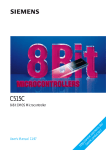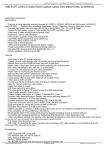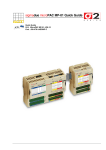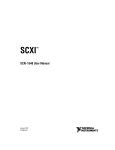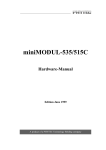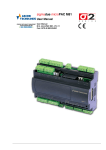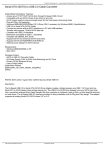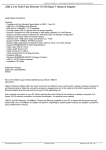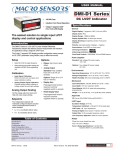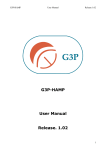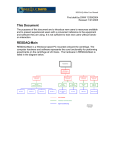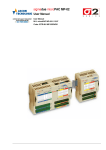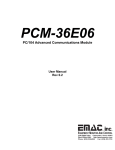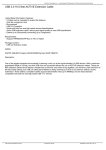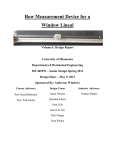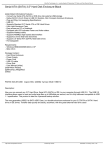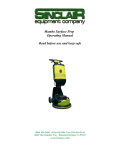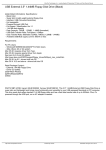Download FEATURES What`s New at EMAC: Product Highlight :
Transcript
Welcome to EMAC E-mail, a newsletter from EMAC, provider of single board computers, peripherals, and custom engineering to meet your embedded systems needs. FEATURES 1. 2. 3. 4. 5. 6. What's New at EMAC: Electronic Primer Manuals, New Support Web Page Product Highlight: Controller Area Network Products Newsletter Promotion: Primer PAK (Primer Academic Kit) Technical Forum: Controller Area Network (CAN) Protocol Engineering Success Story: Anatol Automation EMAC Extras: EMAC Specials What's New at EMAC: Electronic Primer Manuals The Primer Trainer manuals are now in electronic format and easily accessible from the support CD-ROM or our web site. The support CD-ROM now comes with each purchase, this means no more heavy manuals to carry or lost pages. Paper manuals are still available by request. New Support Web Page To better serve you, we have revised our product support page with new features. This new page allows a customer to ask questions before a purchase or request technical assistance after the sale. Simply fill in the appropriate contact information, type your inquiry in the message field, and submit. Each instance of a particular issue is logged so that a complete history of the issue is maintained throughout the correspondance. Our highly-trained technical staff will reply to your inquiry within one business day. Product Highlight : MicroPac 515C The MicroPac series of single board computers feature micro size with micro power consumption at a micro price. The MicroPac 515C has dimensions of 5.375" by 3.625" with a power requirement of 45 ma. typical and 80 ma. with the DUART upgrade option installed. The MicroPac 515C single board computer utilizes the Infineon C515C microprocessor. EMAC integrated this powerful processor onto a board that can provide up to 32 digital I/O lines, 4 serial RS-232/485 ports, 128K of Flash or ROM, 512K of RAM, serial EEPROM, CAN interface, LCD interface, keypad interface, SPI compatible interface, 8 channels of A/D, and 4 channels of D/A. The MicroPac 515C is ideally suited for controller applications requiring in-circuit Flash reprogramming, onboard graphic or character LCDs and/or keypad interface circuitry. It is also ideal for low cost data acquisition and control applications. The 8 channels of A/D allow the board to be connected to temperature sensors, pressure sensors, strain gauges, and LVDTs. Conditioned signals from these sensors can be used to make decisions in controlling motors, lights, heaters, etc. For additional details, contact the EMAC Sales department at [email protected] and visit our product web page at http://www.emacinc.com/sbc_microcontrollers/micropac515.htm. PCD-E12 The PCD-E12 Analog and Digital I/O Daughter Board adds microcontroller capability to the NEW PCM-53E52. The PCD-E12 features a Motorola HC12 processor, one CAN 2.0B port, one RS-232 port with handshake, 24 Digital I/O lines, eight high current sink outputs on a standard I/O Rack compatible 50 pin header, and 16 channels of A/D with 10-bit resolution (0 to 5V). The PCD-E12 also features onboard options such as eight channels of A/D 12-bit resolution (0 to 5V), four channels of D/A with 12-bit resolution, and a second RS-422/485 serial port for standalone use. In addition, the I/O daughter board supports up to a 24-key keypad and is capable of driving up to a 40 x 4 character LCD display. For additional details, contact the EMAC Sales department at [email protected] and visit our PCM-53E52 web page at http://www.emacinc.com/pc_compatible_sbcs_info/pcm53e52.htm. PCM-36E81 The PCM-36E81 is a special purpose PC/104 communication module which offers connectivity of the Controller Area Network to your embedded PC. With the built-in CAN controller, the PCM-36E81 provides bus arbitration and error detection with automatic transmission repeat function. EMAC has CAN / CANopen OS drivers available. Newsletter/ Web Promotion : Primer PAK Educational institutions have frequently asked whether or not EMAC, Inc. sells a comprehensive microprocessor training kit. The kit should include a power supply to power the equipment, an interface to transfer programs to/from a desktop PC, and a case to store the equipment safely in a dust-free/static-free environment. In response to these inquiries, EMAC is now offering the Primer Academic Kit or "PAK". This Kit includes the following items: Primer Trainer, assembled and tested, including Self-Instruction Manual (in .pdf format, on CD) Applications Manual (in .pdf format, on CD) Distribution Utilities (on CD) Deluxe Upgrade RS232 serial port RS232 serial interface cable (for PC connectivity) 32K battery-backed RAMdisk with real-time clock I/O Interface Cable Heavy Duty Keypad Enhanced Monitor Operating System (EMOS) EPROM w/ software EMOS User's Manual (in .pdf format, on CD) Wall transformer power supply, 9V @ 500mA Hard shell case The Primer PAK provides an excellent educational platform for students and hobbyists interested in computer programming, electronics, robotics, and automation. From now until January 31, EMAC is offering the Primer PAK for just $299.00, a savings of $50.00 off the retail price. For more details, visit our Primer Trainer and Universal Trainer web pages at http://www.emacinc.com/primer_pak.htm or contact EMAC directly at [email protected]. Technical Forum: Controller Area Network (CAN) Protocol The Controller Area Network (CAN) protocol was developed in Europe, by Robert Bosch GmbH, for the automotive industry. With the greater demand for safety, comfort, convenience, and pollution control, the automotive industry has developed many electronic systems. These electronic systems, such as ABS, EMS, SRS, traction control, and power seats, need to communicate with each other in real time. The CAN protocol is able to communicate with a two wire serial bus and maximum speeds of up to 1Mbit/s over a bus length of 40 meters. The CAN protocol is a growing solution for reducing cost and increasing the reliability of industrial applications such as elevator control systems, factory automation, and medical systems. The ISO/OSI Layer 1 and Layer 2 are described in the international standards ISO 11519-2 Standard CAN 2.0A for low speed applications and ISO 11898 Extended CAN 2.0B for high speed applications. The Standard CAN protocol 2.0A supports messages with 11 bit identifiers. The Extended CAN protocol 2.0B supports both 11 bit and 29 bit identifiers. Most CAN 2.0A controllers can transmit and receive only Standard format messages, although some (known as 2.0B passive) will receive Extended format messages-but then ignore them. Extended CAN 2.0B controllers can send and receive messages in both formats. The ISO 11898 standard "Recommends" that bus interface chips be designed so that communication can still continue when either of the two wires in the bus is broken, either wire is shorted to power, or either wire is shorted to ground. The CAN will operate in extremely harsh environments and the extensive error checking mechanism ensures that any transmission errors are detected. Like Ethernet, the CAN 2.0 protocol operates in the Carrier-Sense/Multiple Access and Collision Detection CSMA/CD mode. The difference between CAN and Ethernet approach occurs when two devices simultaneously determine that the bus is not busy, and both start to transmit. This leads to bus contention. When bus contention occurs CAN will arbitrate bus access on a bit-by-bit basis. The device with the highest priority prevails and continues to transmit data; the device with lower priority tries again. The advantages of CAN are standardization, robustness, and its use of less wiring. The CAN 2.0B protocol is ISO 11898 standardized. This means that each node operates at the same baud rate and all hardware is consistent from node to node. The CAN is able to continue operation in some of the most extreme conditions. CAN was developed to work with circuit noise, short circuits, and voltage variations. The CAN protocol also has the ability of adding or removing nodes without damaging the system or shutting down the network. Using a network eliminates point to point wiring, reduces cost, and increases reliability. For further information on the CAN Protocol and its specifications go to: http://www.can.bosch.com/index.html Engineering Success Story: Anatol Reference Story When Anatol Automation was getting ready to design their new automated high-tech screen printer they came to EMAC the Single Board Computer (SBC) experts. EMAC set them up with a SBC connected to an LCD with Touchscreen with Linux on Flash Disk. In addition Anatol required distributed motor control of up to 16 motors. EMAC responded by adding a PC/104 dual isolated CAN board and wrote custom Linux CANopen drivers to talk to networked AMC digital motor drive controllers. The integration of all this hardware in a small embedded package from a single vendor was very desirable for Anatol. EMAC Extras: EMAC Specials This month’s SPECIAL is the: SBC-555 … Pentium Half-size ISA CPU card … $265.00 SBC-555 - http://www.emacinc.com/pc_compatible_sbcs_info/sbc555.htm All the items on the EMAC Specials page are either discontinued or must leave our inventory. However, these products are NEW and have a full two-year warranty. As always these products have EMACs service and reliability to back them. These items could serve as a prototype for a new product without the cost of newer more expensive boards. At the same time they could serve as an inexpensive alternative to the one time application or to the basement tinkering. So don't be the last to pick up these great specials as they are of limited quantities. EMAC Specials - http://www.emacinc.com/emac_specials.htm EMAC, Inc. Homepage: http://www.emacinc.com Copyright © 2002 EMAC, Inc. All Rights Reserved. All product names contained herein are the trademarks of their respective holders. If you wish to unsubscribe to this newsletter, click on the following: http://www.emacinc.com/newsletter/unsubscribe.php





